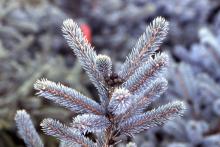Cause A physiological disorder that affects the uppermost bud(s) on the terminal shoot (leader) of Colorado blue spruce (Picea pungens). Possibly caused by either a calcium deficiency or by high temperatures the previous growing season. Genetics likely play a role in tree susceptibility.
Gemmamyces piceae causes a bud blight disease on several spruce species (Picea spp.) in Alaska, Europe and Asia. This disease, however, leads to defoliation and death of the tree.
Symptoms Bud Failure - The first evidence of bud failure is in late winter when the terminal bud, especially on the leader, appears to die. It first turns ash-gray to dark brown, then hard and resinous. Sometimes, the stem just below the bud dies back a short distance (0.5 to 4 inches). Needles on the shoot near the terminal bud become chlorotic (yellow) and soon drop. In spring, buds below the affected stem grow normally and compete for dominance. This results in a tree with multiple leaders. Repeated damage results in stunted, wide trees. Occasionally, buds on lateral branches are damaged.
Bud Blight - One or two small brownish or reddish lesions can be found in the spring. Many infected buds may be killed and will not sprout. During bud break the lesions become enlarged and infected shoots twisted around the developed lesions. Almost all of the infected shoots subsequently die that summer.
Cultural control
- Prune or train the tree in summer to a single leader for bud failure.
- Management tactic for bud blight have not been proposed.
Reference Peralta, S. M. G., Adams, G. C., Winton, L., Cerny, K. and Everhart, S. E., 2020. An outbreak of bud blight disease of spruce (Picea spp.) in Alaska: an epidemiological study of Gemmamyces piceae. Plant Health 2020 Online.

